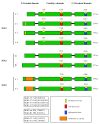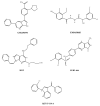Serum and Glucocorticoid-Inducible Kinase 1 (SGK1) in NSCLC Therapy
- PMID: 33266470
- PMCID: PMC7700219
- DOI: 10.3390/ph13110413
Serum and Glucocorticoid-Inducible Kinase 1 (SGK1) in NSCLC Therapy
Abstract
Non-small cell lung cancer (NSCLC) remains the most prevalent and one of the deadliest cancers worldwide. Despite recent success, there is still an urgent need for new therapeutic strategies. It is also becoming increasingly evident that combinatorial approaches are more effective than single modality treatments. This review proposes that the serum and glucocorticoid-inducible kinase 1 (SGK1) may represent an attractive target for therapy of NSCLC. Although ubiquitously expressed, SGK1 deletion in mice causes only mild defects of ion physiology. The frequent overexpression of SGK1 in tumors is likely stress-induced and provides a therapeutic window to spare normal tissues. SGK1 appears to promote oncogenic signaling aimed at preserving the survival and fitness of cancer cells. Most importantly, recent investigations have revealed the ability of SGK1 to skew immune-cell differentiation toward pro-tumorigenic phenotypes. Future studies are needed to fully evaluate the potential of SGK1 as a therapeutic target in combinatorial treatments of NSCLC. However, based on what is currently known, SGK1 inactivation can result in anti-oncogenic effects both on tumor cells and on the immune microenvironment. A first generation of small molecules to inactivate SGK1 has already been already produced.
Keywords: NSCLC; SGK1; chemotherapy; immunotherapy.
Conflict of interest statement
The authors declare no conflict of interest.
Figures
Similar articles
-
Inhibition of SGK1 potentiates the anticancer activity of PI3K inhibitor in NSCLC cells through modulation of mTORC1, p‑ERK and β‑catenin signaling.Biomed Rep. 2023 Oct 13;19(6):94. doi: 10.3892/br.2023.1676. eCollection 2023 Dec. Biomed Rep. 2023. PMID: 37901878 Free PMC article.
-
The prospect of serum and glucocorticoid-inducible kinase 1 (SGK1) in cancer therapy: a rising star.Ther Adv Med Oncol. 2020 Jul 15;12:1758835920940946. doi: 10.1177/1758835920940946. eCollection 2020. Ther Adv Med Oncol. 2020. PMID: 32728395 Free PMC article. Review.
-
Serum and glucocorticoid kinase 1 promoted the growth and migration of non-small cell lung cancer cells.Gene. 2016 Jan 15;576(1 Pt 2):339-46. doi: 10.1016/j.gene.2015.10.072. Epub 2015 Nov 11. Gene. 2016. PMID: 26548813
-
Serum and glucocorticoid-regulated kinase 1 (SGK1) is a predictor of poor prognosis in non-small cell lung cancer, and its dynamic pattern following treatment with SGK1 inhibitor and γ-ray irradiation was elucidated.Oncol Rep. 2018 Mar;39(3):1505-1515. doi: 10.3892/or.2018.6181. Epub 2018 Jan 3. Oncol Rep. 2018. PMID: 29328462
-
Regulation of ion channels by the serum- and glucocorticoid-inducible kinase SGK1.FASEB J. 2013 Jan;27(1):3-12. doi: 10.1096/fj.12-218230. Epub 2012 Sep 25. FASEB J. 2013. PMID: 23012321 Review.
Cited by
-
SGK1 mutation status can further stratify patients with germinal center B-cell-like diffuse large B-cell lymphoma into different prognostic subgroups.Cancer Med. 2022 Mar;11(5):1281-1291. doi: 10.1002/cam4.4550. Epub 2022 Feb 1. Cancer Med. 2022. PMID: 35106936 Free PMC article.
-
Characterization of lncRNA-Based ceRNA Network and Potential Prognostic Hub Genes for Sepsis.Evid Based Complement Alternat Med. 2022 Jun 21;2022:1485033. doi: 10.1155/2022/1485033. eCollection 2022. Evid Based Complement Alternat Med. 2022. Retraction in: Evid Based Complement Alternat Med. 2023 Jun 21;2023:9851697. doi: 10.1155/2023/9851697 PMID: 35774747 Free PMC article. Retracted.
-
Highly Antiproliferative Latonduine and Indolo[2,3-c]quinoline Derivatives: Complex Formation with Copper(II) Markedly Changes the Kinase Inhibitory Profile.J Med Chem. 2022 Feb 10;65(3):2238-2261. doi: 10.1021/acs.jmedchem.1c01740. Epub 2022 Feb 1. J Med Chem. 2022. PMID: 35104137 Free PMC article.
-
AGC kinase inhibitors regulate STING signaling through SGK-dependent and SGK-independent mechanisms.Cell Chem Biol. 2023 Dec 21;30(12):1601-1616.e6. doi: 10.1016/j.chembiol.2023.10.008. Epub 2023 Nov 7. Cell Chem Biol. 2023. PMID: 37939709 Free PMC article.
-
Mechanism of chronic stress to promote tumor development and the intervention.Zhong Nan Da Xue Xue Bao Yi Xue Ban. 2022 Sep 28;47(9):1281-1288. doi: 10.11817/j.issn.1672-7347.2022.210589. Zhong Nan Da Xue Xue Bao Yi Xue Ban. 2022. PMID: 36411713 Free PMC article. Chinese, English.
References
-
- Travis W.D., Brambilla E., Nicholson A.G., Yatabe Y., Austin J.H.M., Beasley M.B., Chirieac L.R., Dacic S., Duhig E., Flieder D.B., et al. The 2015 World Health Organization Classification of Lung Tumors: Impact of Genetic, Clinical and Radiologic Advances Since the 2004 Classification. J. Thorac. Oncol. 2015;10:1243–1260. doi: 10.1097/JTO.0000000000000630. - DOI - PubMed
-
- Kuhn E., Morbini P., Cancellieri A., Damiani S., Cavazza A., Comin C.E. Adenocarcinoma classification: Patterns and prognosis. Pathologica. 2018;110:5–11. - PubMed
Publication types
Grants and funding
LinkOut - more resources
Full Text Sources



